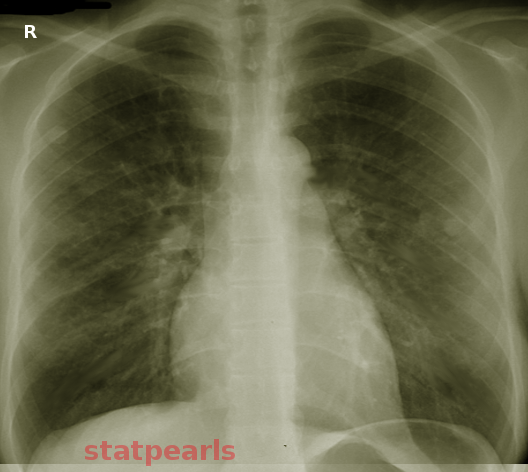[1]
Dries DJ. ARDS: From Syndrome to Disease: Prevention and Genomics. Air medical journal. 2019 Jan-Feb:38(1):7-9. doi: 10.1016/j.amj.2018.11.018. Epub 2019 Jan 15
[PubMed PMID: 30711090]
[2]
Skalická H, Bělohlávek J. [Non-cardiogenic pulmonary edema, acute respiratory distress syndrome]. Casopis lekaru ceskych. 2015:154(6):273-9
[PubMed PMID: 26750623]
[4]
Patti R, Ponnusamy V, Somal N, Sinha A, Sharma S, Yoon TS, Kupfer Y. Naloxone-Induced Noncardiogenic Pulmonary Edema. American journal of therapeutics. 2020 Nov/Dec:27(6):e672-e673. doi: 10.1097/MJT.0000000000001037. Epub
[PubMed PMID: 31789629]
[6]
Luks AM, Swenson ER, Bärtsch P. Acute high-altitude sickness. European respiratory review : an official journal of the European Respiratory Society. 2017 Jan:26(143):. doi: 10.1183/16000617.0096-2016. Epub 2017 Jan 31
[PubMed PMID: 28143879]
[8]
Suhail Najim M, Ali Mohammed Hammamy R, Sasi S. Neurogenic Pulmonary Edema Following a Seizure: A Case Report and Literature Review. Case reports in neurological medicine. 2019:2019():6867042. doi: 10.1155/2019/6867042. Epub 2019 Oct 9
[PubMed PMID: 31687236]
Level 3 (low-level) evidence
[9]
Akunov AC, Sartmyrzaeva MA, Maripov AM, Muratali Uulu K, Mamazhakypov AT, Sydykov AS, Sarybaev AS. High Altitude Pulmonary Edema in a Mining Worker With an Abnormal Rise in Pulmonary Artery Pressure in Response to Acute Hypoxia Without Prior History of High Altitude Pulmonary Edema. Wilderness & environmental medicine. 2017 Sep:28(3):234-238. doi: 10.1016/j.wem.2017.04.003. Epub 2017 Jun 30
[PubMed PMID: 28673745]
[12]
Fernandes Júnior CJ, Hidal JT, Barbas CS, Akamine N, Knobel E. Noncardiogenic pulmonary edema complicating diabetic ketoacidosis. Endocrine practice : official journal of the American College of Endocrinology and the American Association of Clinical Endocrinologists. 1996 Nov-Dec:2(6):379-81
[PubMed PMID: 15251497]
[13]
Malhotra A, Drazen JM. High-frequency oscillatory ventilation on shaky ground. The New England journal of medicine. 2013 Feb 28:368(9):863-5. doi: 10.1056/NEJMe1300103. Epub 2013 Jan 22
[PubMed PMID: 23339640]
[14]
Cohen DL, Post J, Ferroggiaro AA, Perrone J, Foster MH. Chronic salicylism resulting in noncardiogenic pulmonary edema requiring hemodialysis. American journal of kidney diseases : the official journal of the National Kidney Foundation. 2000 Sep:36(3):E20
[PubMed PMID: 10977813]
[15]
Radke JB, Owen KP, Sutter ME, Ford JB, Albertson TE. The effects of opioids on the lung. Clinical reviews in allergy & immunology. 2014 Feb:46(1):54-64. doi: 10.1007/s12016-013-8373-z. Epub
[PubMed PMID: 23636734]
[16]
Tank S, Sputtek A, Kiefmann R. [Transfusion-related acute lung injury]. Der Anaesthesist. 2013 Apr:62(4):254-60. doi: 10.1007/s00101-013-2163-0. Epub
[PubMed PMID: 23558721]
[17]
Korzeniewski K, Nitsch-Osuch A, Guzek A, Juszczak D. High altitude pulmonary edema in mountain climbers. Respiratory physiology & neurobiology. 2015 Apr:209():33-8. doi: 10.1016/j.resp.2014.09.023. Epub 2014 Oct 5
[PubMed PMID: 25291181]
[18]
Romero Osorio OM, Abaunza Camacho JF, Sandoval Briceño D, Lasalvia P, Narino Gonzalez D. Postictal neurogenic pulmonary edema: Case report and brief literature review. Epilepsy & behavior case reports. 2018:9():49-50. doi: 10.1016/j.ebcr.2017.09.003. Epub 2017 Sep 28
[PubMed PMID: 29692972]
Level 3 (low-level) evidence
[19]
Yabuki H, Watanabe T, Oishi H, Katahira M, Kanehira M, Okada Y. Muse Cells and Ischemia-Reperfusion Lung Injury. Advances in experimental medicine and biology. 2018:1103():293-303. doi: 10.1007/978-4-431-56847-6_16. Epub
[PubMed PMID: 30484236]
Level 3 (low-level) evidence
[20]
Kim J, Na S. Transfusion-related acute lung injury; clinical perspectives. Korean journal of anesthesiology. 2015 Apr:68(2):101-5. doi: 10.4097/kjae.2015.68.2.101. Epub 2015 Mar 30
[PubMed PMID: 25844126]
Level 3 (low-level) evidence
[21]
Matthay MA, Zemans RL, Zimmerman GA, Arabi YM, Beitler JR, Mercat A, Herridge M, Randolph AG, Calfee CS. Acute respiratory distress syndrome. Nature reviews. Disease primers. 2019 Mar 14:5(1):18. doi: 10.1038/s41572-019-0069-0. Epub 2019 Mar 14
[PubMed PMID: 30872586]
[22]
Sterrett C, Brownfield J, Korn CS, Hollinger M, Henderson SO. Patterns of presentation in heroin overdose resulting in pulmonary edema. The American journal of emergency medicine. 2003 Jan:21(1):32-4
[PubMed PMID: 12563576]

